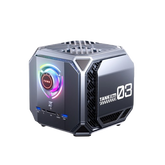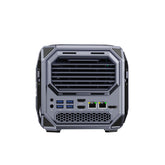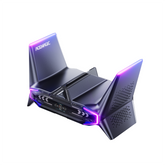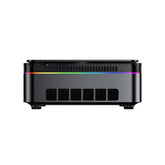DisplayPort vs HDMI: What is the difference?
Most users have two well-known options to choose from when picking a display interface: DisplayPort and HDMI. They both transmit video and audio signals but differ in bandwidth, compatibility, and application. Here we'll discuss their histories, technical information, real-world applications, and present standards so that you may pick the correct connection for your setup.

What is HDMI?
HDMI, or High-Definition Multimedia Interface, was introduced in 2002 by a consortium of companies that included Sony, Panasonic, Philips, and Toshiba. The primary motivation was to consolidate older analog connections such as VGA and component video into one digital standard that could transmit video and audio.
HDMI has been revised a number of times since, increasing bandwidth and adding features such as HDR (High Dynamic Range), variable refresh rate (VRR), and improved Audio Return Channel (eARC). The connector itself is compact and comes in three common forms:
- Type A (standard HDMI): widespread on TVs, monitors, and graphics cards.
- Type C (mini HDMI): common on tablets and cameras.
- Type D (micro HDMI): used in compact devices such as some smartphones or portable projectors.
HDMI’s strength lies in its dominance across consumer electronics. It is the default port on nearly every TV, streaming device, and game console, making it highly versatile for home entertainment.
Summary of HDMI:
- First release: 2002
- Common devices: TVs, Blu-ray players, game consoles, laptops
- Core advantage: broad compatibility across consumer products
- Built-in features: ARC, eARC, CEC, HDR support
Further Reading: HDMI vs. Micro HDMI vs. Mini HDMI: The Ultimate Comparison Guide
What is DisplayPort?
DisplayPort was created by the Video Electronics Standards Association (VESA) in 2006 as a more recent option than VGA and DVI for computer displays. In contrast to HDMI, which was targeted at living room entertainment, DisplayPort was conceived first and primarily for PCs, professional monitors, and graphics-intensive applications.
One of its key features is higher bandwidth scalability, allowing for increased resolutions and refresh rates. DisplayPort also natively supports Multi-Stream Transport (MST), allowing multiple monitors to be daisy-chained from a single port — a functionality not natively offered by HDMI.
DisplayPort connectors have two notable forms:
- Standard DisplayPort: full-size connector, common on desktop GPUs and monitors.
- Mini DisplayPort: smaller form factor version created by Apple, subsequently used on laptops and small form factor systems.
DisplayPort today is ubiquitous on graphics cards, professional monitors, and gaming PCs. It's also part of USB-C via DisplayPort Alt Mode, giving newer laptops a versatile way to connect to external monitors.
Summary of DisplayPort:
- Release year: 2006
- Common devices: PC monitors, GPUs, docking stations
- Main advantage: high bandwidth and multi-monitor capability
- Builtin features: Adaptive Sync, MST, HDR support
Technical Comparison: HDMI vs DisplayPort Versions
| Version | Bandwidth | Max Resolution & Refresh Rate | Key Features | Typical Use |
|---|---|---|---|---|
| HDMI 1.4 (2009) | 10.2 Gbps | 4K at 30 Hz | ARC, 3D video | Older projectors, TVs |
| HDMI 2.0 (2013) | 18 Gbps | 4K at 60 Hz | HDR10, BT.2020 color | Mid-range monitors, 4K TVs |
| HDMI 2.0a/b (2015–2016) | 18 Gbps | 4K at 60 Hz | HDR10+, HLG HDR | Prevalent in UHD TVs |
| HDMI 2.1 (2017) | 48 Gbps | 10K at 120 Hz, 8K at 60 Hz, 4K at 120 Hz | eARC, VRR, ALLM, DSC | Xbox Series X, PS5, newer TVs |
| HDMI 2.1a (2022) | 48 Gbps | Same as 2.1 | Source-Based Tone Mapping (SBTM) | Newest TVs, high-end displays |
| DisplayPort 1.2 (2010) | 21.6 Gbps | 4K at 60 Hz | MST (multi-monitor), Adaptive Sync | PC monitors, workstations |
| DisplayPort 1.3 (2014) | 32.4 Gbps | 5K at 60 Hz, 4K at 120 Hz | HDR, MST | High-resolution PC monitors |
| DisplayPort 1.4 (2016) | 32.4 Gbps | 8K at 60 Hz, 4K at 240 Hz (with DSC) | HDR10, DSC 1.2 | Gaming monitors, VR |
| DisplayPort 2.0 (2019) | 80 Gbps | 16K at 60 Hz, 10K at 80 Hz | DSC 1.2a, HDR10, multiple 4K monitors | High-end monitors, VR, AR |
| DisplayPort 2.1 (2022) | 80 Gbps | Same as 2.0, but more efficient | Improved cable/USB4 compatibility | Next-gen GPUs, 8K+ displays |
Which to Use: HDMI or DisplayPort?
The right interface mostly comes down to the device and use case. While both can transmit high-quality video and audio, each is more suited to different applications.
Gaming
PC and console gaming put different demands on display connections.
-
HDMI:
- HDMI 2.1 provides 4K at 120 Hz, a requirement for PlayStation 5 and Xbox Series X.
- It supports features such as Variable Refresh Rate (VRR) and Auto Low Latency Mode (ALLM), both of which make gaming smoother on TVs.
- Limitation: Less high-refresh PC monitors use HDMI only; many cap out at 144 Hz over HDMI.
-
DisplayPort:
- DisplayPort 1.4 can push 4K to 240 Hz (with Display Stream Compression).
- DisplayPort 2.0/2.1 raises the stakes with 8K at 60 Hz or 4K at 240 Hz uncompressed.
- Adaptive Sync and G-Sync support also make it the de facto choice for PC gamers.
Conclusion: For console and TV gaming, HDMI 2.1 is the requirement. For PC gaming monitors with ultra-high refresh, DisplayPort provides more space.
Office and Professional Work
- HDMI: Perfectly sufficient for single-monitor office use or connecting to a projector in conference rooms.
- DisplayPort: More appropriate for those using video editing, CAD, or financial data on multiple displays. MST allows the use of two or more monitors with a single port.
Home Entertainment
- HDMI is the dominant one here. It's the norm on TVs, soundbars, AV receivers, and streaming devices. Its eARC feature allows for uncompressed Dolby Atmos or DTS:X audio on one cable.
- DisplayPort plays minimal part in living room configurations since there are not many consumer TVs that feature the port.
Laptops and Portability
- HDMI ports are what most laptops come with since they are plug-and-play with projectors and TVs.
- More premium business and gaming laptops tend to use USB-C with DisplayPort Alt Mode for higher-end monitor connections, which allows for docking stations and multiple display outputs.
HDMI 2.1 vs DisplayPort 2.1
Both DisplayPort 2.1 and HDMI 2.1 are the latest evolution of their standards, published within the last five years. Both provide significantly more bandwidth and resolution than their predecessors but target a different market segment.
Bandwidth and Resolution
HDMI 2.1:
- Bandwidth: 48 Gbps
- Supports 4K at 120 Hz, 8K at 60 Hz, and up to 10K at 120 Hz with compression
- Widely utilized in game consoles and TVs
DisplayPort 2.1:
- Bandwidth: 80 Gbps (almost double HDMI 2.1)
- Handles 8K at 60 Hz uncompressed, 4K at up to 240 Hz, and even 16K at 60 Hz with compression
- Designed for PCs, high-end GPUs, and multi-monitor workstations
Gaming Impact
- Consoles: PlayStation 5 and Xbox Series X only support HDMI 2.1, so it's a necessity for console gamers.
- PC Gaming: DisplayPort 2.1 allows for ultra-high refresh rates beyond what's currently possible with HDMI, a critical advantage for esports gamers.
Compression and Efficiency
- HDMI 2.1 uses Display Stream Compression (DSC) to reach greater resolutions.
- DisplayPort 2.1 also utilizes DSC but can carry greater uncompressed bandwidth, maintaining greater image fidelity at extreme resolutions.
Industry Adoption
- HDMI is still everywhere in consumer electronics because it's present on TVs and AV equipment.
- DisplayPort 2.1 is still rolling out but will be standard on upcoming GPUs from AMD, Intel, and NVIDIA.
Buying Considerations: DisplayPort or HDMI
In deciding between HDMI and DisplayPort, the correct decision boils down largely to what type of device you're connecting and how much performance you need. For monitors, gamers should closely consider if the display is able to support high refresh rates on each interface. Whereas the majority of modern gaming monitors can connect, most of the more advanced models that provide 240 Hz and higher rely on DisplayPort to unleash their full potential. TVs are biased towards HDMI, especially if you would prefer to have 4K at 120 Hz or even 8K video, which requires HDMI 2.1.
The same holds when considering graphics cards. Ninety-nine percent of today's GPUs contain more DisplayPort outputs than HDMI, and for the reason that this standard is so PC-centric. DisplayPort is therefore the handier choice for multi-monitor use, while HDMI is the natural first choice for TVs, VR headsets, and home entertainment boxes. In terms of long-term flexibility, graphics cards that already sport DisplayPort 2.1 offer superior future-proofing, including for silky-smooth 8K output as well as advanced multi-monitor setups.
Quality cable is also important. In order to make the most of HDMI 2.1's more expensive features, such as 120 Hz 4K and eARC, certified Ultra High Speed HDMI cables are required. DisplayPort benefits from certification as well: VESA-certified DP cables are strongly suggested, particularly when longer cable runs are in use, where signal stability can become an issue.
Adapters and converters will also be a factor. There are passive DisplayPort-to-HDMI adapters, but they're only HDMI 1.4 capable and thus top out at 1080p or 4K at 30 Hz. Active adapters are available at higher performance, too, though even then, there may be things that don't carry over between the standards.
Finally, the decision is based on your configuration and long-term plans. A home theater room or a living room packed with consoles will nearly inevitably prefer HDMI 2.1, which is the common standard for TVs and consumer devices. PC gamers, video editors, and business users with several high-resolution monitors will generally find DisplayPort 1.4 or 2.1 the more powerful choice, with higher refresh rate support, scalability, and flexibility for sophisticated workstations.
FAQ
Which is better for gaming, DisplayPort or HDMI?
DisplayPort is usually better for high-refresh-rate PC gaming, while HDMI 2.1 is what you'll want for new consoles.
Which is better for 4K, HDMI or DisplayPort?
They both support 4K. HDMI 2.1 can handle 4K at 120 Hz, while DisplayPort 1.4 and higher can handle 4K up to 240 Hz.
Do I require HDMI 2.1 or DisplayPort 2.1 for 8K?
Yes. HDMI 2.1 is capable of 8K at 60 Hz, but DisplayPort 2.1 can handle 8K at higher refresh rates.
Can I use adapters from HDMI to DisplayPort?
Yes, but active adapters must be used to make them compatible. Some features may be limited.
Is DisplayPort more common on PCs than laptops?
Yes. Desktops and GPUs more typically have multiple DisplayPort outputs. Laptops more typically have HDMI or USB-C with DisplayPort Alt Mode.
Does HDMI 2.1 offer variable refresh rate (VRR)?
Yes. HDMI 2.1 includes VRR, with FreeSync and G-Sync supported on supporting displays.
What kind of cable should I buy for dual monitors?
DisplayPort is better for multi-monitor setups due to MST support. HDMI can be utilized but is less flexible.







Leave a comment
Please note, comments need to be approved before they are published.